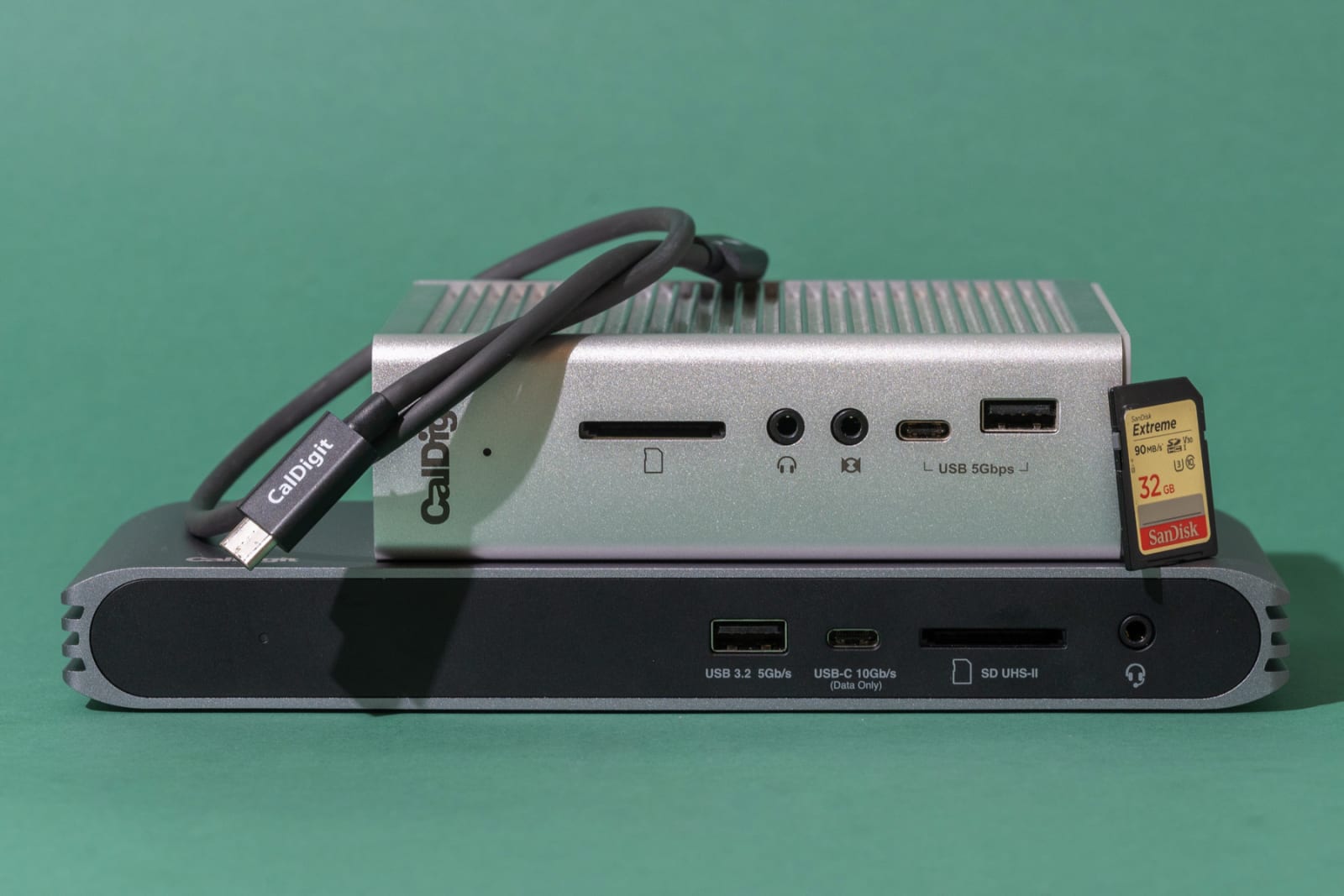
The best Thunderbolt 3 docks
If you have a computer with a Thunderbolt 3 port and want to connect several peripherals, a Thunderbolt dock lets you attach them all with a single cable.
by WirecutterBy Nick Guy
This post was done in partnership with Wirecutter. When readers choose to buy Wirecutter's independently chosen editorial picks, Wirecutter and Engadget may earn affiliate commission. Read the full guide to thunderbolt 3 docks.
After putting in more than 25 hours of research and hands-on testing 13 Thunderbolt 3 docks with more than $7,000 worth of high-end gear, we think CalDigit's TS3 Plus remains the best choice for Mac or PC owners who need to connect multiple displays, USB-A input devices, and high-speed storage. It has more useful ports than most docks, it can charge most laptops at full speed, and it takes up little room on a desk.
The CalDigit TS3 Plus has the most useful array of connections we found, starting with two Thunderbolt 3 ports, five USB-A ports, and two USB-C ports (one USB 3.2 Gen 1, one USB 3.2 Gen 2). It also has an SD card slot, a DisplayPort connector (which works with HDMI via an inexpensive adapter), Gigabit Ethernet, audio-in and -out jacks, and an S/PDIF jack for digital optical audio—the last one a rarity in these devices. And while most docks have a horizontal orientation, you can also position the TS3 Plus vertically to minimize its footprint. All current Apple laptops and desktops have Thunderbolt 3 ports, as do a lot of newer PCs, such as our top ultrabook picks; check your computer's manual. If a cheaper USB-C hub or dock can't meet your needs and you need the extra bandwidth of Thunderbolt 3, this CalDigit model has the best combination of ports, size, and shape we've yet found.
CalDigit's USB-C Pro Dock is less expensive than the TS3 Plus but has most of the same features. It's also designed to be compatible with computers that have USB-C but not Thunderbolt 3, making it a good fit if you need a dock that can work with lots of different kinds of computers. This dock has three fewer USB ports (three are USB-A, and one is USB-C), an SD card slot, two DisplayPort outputs, Ethernet, and audio, and it supports the same 85-watt power output. But it doesn't have a spare Thunderbolt 3 port, so you can't daisy-chain Thunderbolt devices. The USB-C Pro Dock is also larger than the TS3 Plus, but for the price, we think this model's sacrifices are forgivable.
In addition to a middle-of-the-road three USB-A ports, the HP Thunderbolt Dock 120W G2 offers a second USB-C port, making this dock more useful if you have more modern accessories and don't need access to as many older devices at once. It also includes two DisplayPort connectors, so you can attach two displays at the same time without taking up your Thunderbolt 3 port. We like its small cube shape and its low price.
Why you should trust us
I was the accessories editor at iLounge for a little more than three years and have been covering accessories at Wirecutter for a little longer than that. During my tenure, I've reviewed more than 1,000 iOS and Mac products, including numerous docking stations over several iterations of this guide.
Who needs this
If you have a computer with a Thunderbolt 3 port and want to connect several peripherals—displays, drives, printers, and such—a Thunderbolt dock lets you attach them all with a single cable. If you use a laptop as your main computer and regularly move that laptop to and from a desk with multiple peripherals, you can leave all of those accessories plugged into the dock so that when you sit down at your desk, you can simply plug your Thunderbolt cable into the laptop to connect everything instantly.
A Thunderbolt dock is also useful if your Thunderbolt-equipped computer doesn't have enough ports and connections, or if those connections are inconveniently located. You can run a single Thunderbolt cable from the computer to the dock and put the dock somewhere more accessible.
Thunderbolt docks are ideal for creative professionals and other people who demand a lot from their computers, including the fastest possible transfer speeds and the widest port selection. Most people, however, are just as well served by a much less expensive USB-C dock. These docks use the same connector and can do almost all the same things, but they don't support Thunderbolt 3 transfer speeds and don't usually include the same quantity or variety of ports.
If you have an older computer with Thunderbolt or Thunderbolt 2 (which each use a Mini DisplayPort connector instead of USB-C) and plan to eventually upgrade your computer, you could buy a dedicated Thunderbolt 2 dock. Instead, however, you should be able to use any Thunderbolt 3 dock with Apple's Thunderbolt 3 (USB-C) to Thunderbolt 2 Adapter. The performance will be limited to Thunderbolt 2 speeds (and you won't be able to charge a laptop or use DisplayPort displays through the adapter), but you won't have to upgrade your dock when you upgrade the computer.
USB-C vs. Thunderbolt 3
Although USB-C and Thunderbolt 3 use the same USB-C connector, they aren't the same thing. As this Intel blog post explains, Thunderbolt 3 does everything that USB-C can do plus a few extra Thunderbolt-only features. Specifically, Thunderbolt 3 supports faster data-transfer rates (up to 40 Gbps, versus a maximum of 5 or 10 Gbps for USB-C depending on the device), allows data to transfer in both directions at the same time (useful when you're connecting a slew of devices through one cable), and can simultaneously transfer data, output video, charge your computer, and daisy-chain other Thunderbolt devices over a single cable.
Although having fewer different types of connectors is generally good, it can get confusing when the same connector does different things depending on the computer. You won't hurt anything by plugging a Thunderbolt 3 device into a USB-C port, but if you do that, the device won't work like it's supposed to, so check your manual and confirm which connectors your computer has. Thunderbolt is more expensive for computer vendors to include, so you'll find it mainly on recent Macs (except for the 12-inch MacBook) and higher-end Windows PCs such as our top ultrabook picks. If your computer has USB-C but not Thunderbolt 3, the docks in this guide aren't for you—check out our guide to USB-C accessories.
How we picked and tested
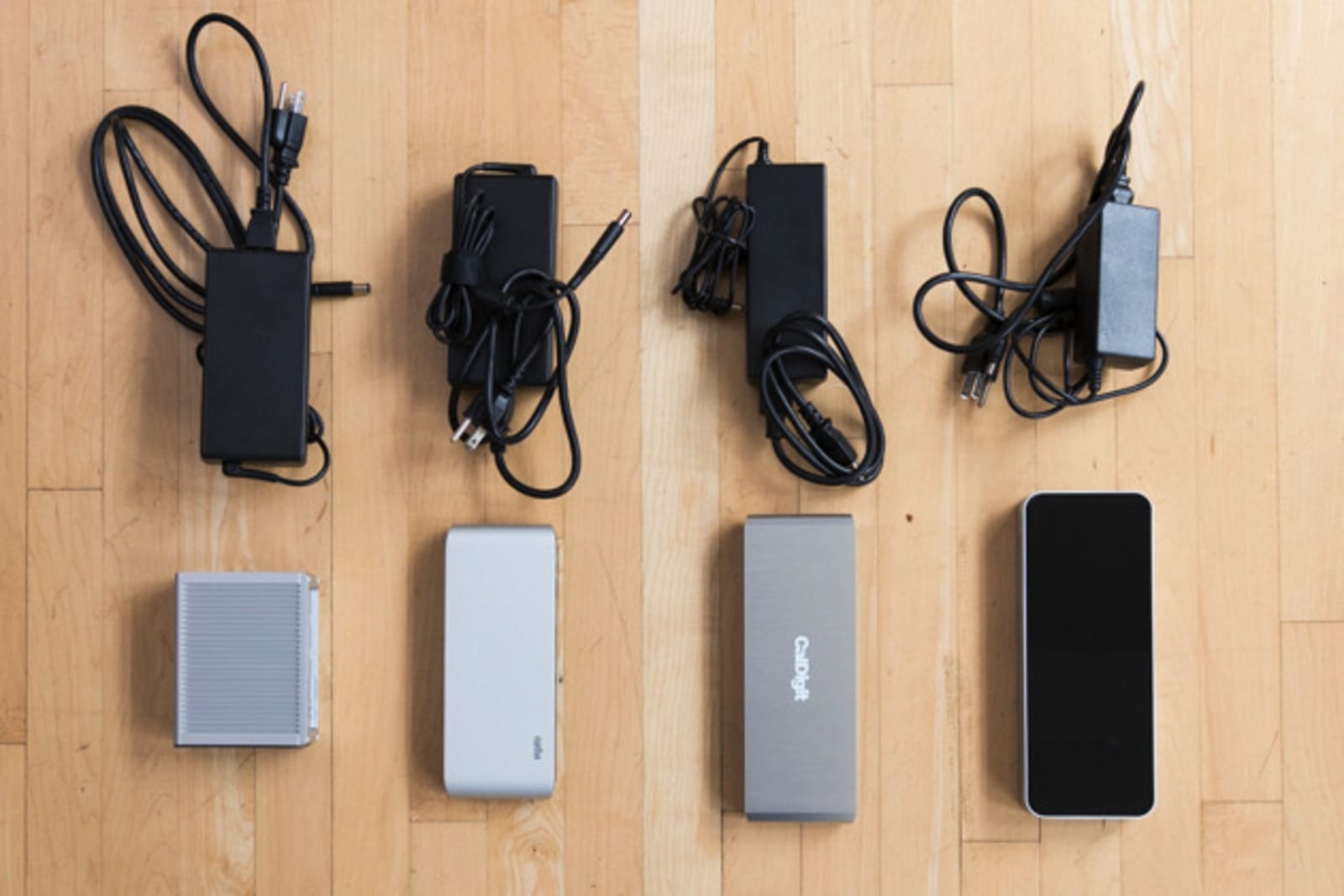
Some of the Thunderbolt docks we tested, sitting below their power adapters. Photo: Michael Hession
A great Thunderbolt dock extends the functionality of the computer that it's connected to by offering additional connections, each at the fastest speeds. These docks are particularly useful for computers that have a limited number and variety of ports, such as the current 13-inch MacBook Pro with two Thunderbolt ports, but they're also useful for more conveniently connecting peripherals to a desktop or laptop computer. We looked for the following features in evaluating our picks:
- Port selection: In general, more ports are better, but we especially prefer practical ports such as USB-A and video output. Less-common ports, including FireWire and eSATA, are appreciated but not necessary.
- Port performance: Devices connected via the Thunderbolt 3 dock should perform almost as well as devices connected directly to the computer. (We discuss, below, our test procedure for each type of port.)
- Design and size: Everything else being equal, a smaller dock is better for your desk than a larger one. We also prefer docks that you can stand on end to take up even less space.
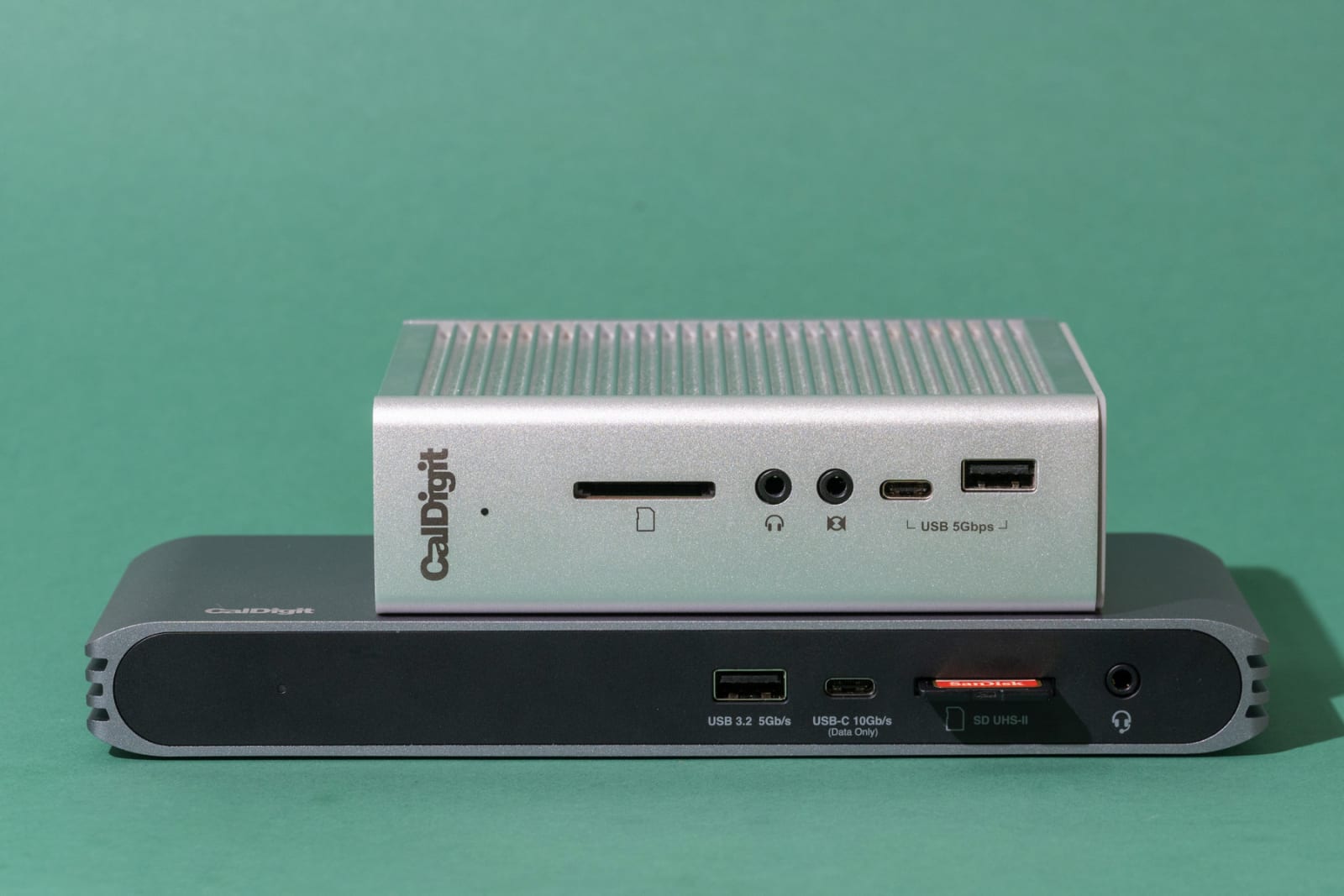
Most Thunderbolt docks are designed to lie horizontally, with a majority of their ports on the back, though some models (including our top pick from CalDigit, top) can stand on end to save desk space. Photo: Michael Murtaugh
Thunderbolt docks have always been somewhat niche, so you won't find many. We've tested almost every dock that has been released since June 2017. For all models, we've used a 2017 Touch Bar–equipped 13-inch MacBook Pro to test speeds, and for the models we tested in 2018 we also confirmed compatibility with a Dell XPS 13 laptop. Specifically, we've run the following tests:
- USB-A: We ran AJA System Test speed tests using Samsung's Portable SSD T3. To measure how fast each dock could charge other devices, we connected a 10.5-inch iPad Pro and read the power draw with PortaPow's USB Power Monitor.
- Thunderbolt 3: We ran AJA System Test speed tests using LaCie's Bolt 3. To measure charge speed, we read the results in the 13-inch MacBook Pro's system report and verified them against the readings on a Satechi USB-C Power Meter.
- USB-C: We ran AJA System Test using Samsung's Portable SSD T3. To measure charge speed, we connected a Drok USB Load Tester and then turned up the amperage of the load tester as far as it could go without overloading the dock, recording the volts and amps to calculate the maximum output (watts).
- HDMI: We connected each of the docks via HDMI to a BenQ BL2711U 27-Inch 4K Monitor with the resolution set to 4K; we repeated this test using a Mini DisplayPort–to–DisplayPort cable running from each dock's Thunderbolt port to the display.
- DisplayPort/Mini DisplayPort: We connected each of the docks via DisplayPort to a Dell 4K monitor or an LG 27MU88-W monitor with the resolution set to 4K, and we used Blur Busters Motion Tests to verify the refresh rate.
- Audio: We tested each dock's audio inputs and outputs by plugging microphone-equipped headphones into each of the dock's audio jacks, making sure the input or output source was properly set in macOS and monitoring the resulting audio levels.
- FireWire: We connected an SSD-equipped version of OWC's Mercury Elite Pro Mini and measured the transfer speed using AJA System Test.
- Ethernet: We verified the connection speed in Network Utility on a Mac, which displays the link speed.
- SD card: We ran AJA System Test on a 64 GB SanDisk Extreme Pro.
The best Thunderbolt 3 dock: CalDigit TS3 Plus
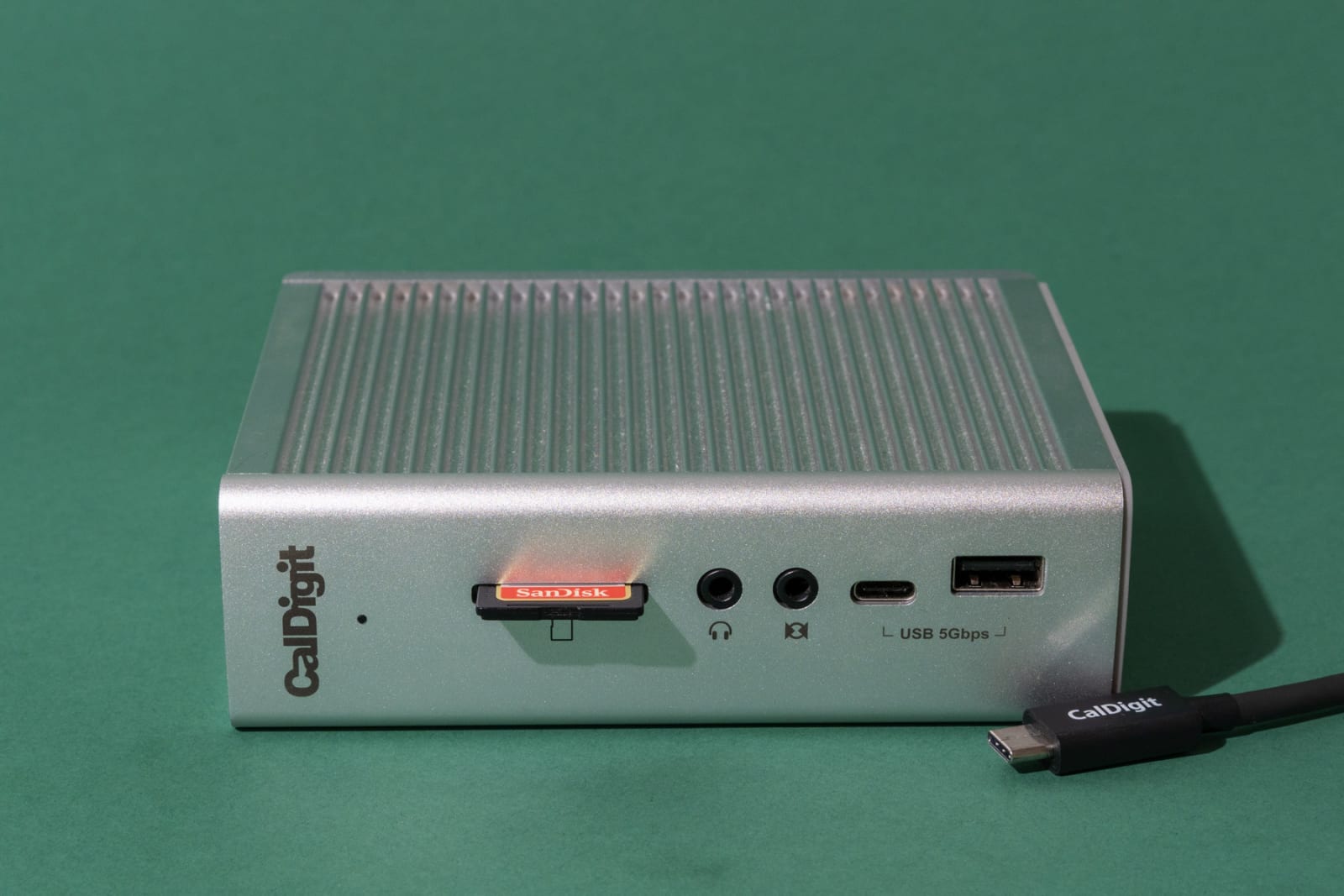
Photo: Michael Murtaugh
CalDigit's TS3 Plus is the best Thunderbolt 3 dock for most people because it offers more USB-A ports than almost all of the competition and provides USB-C ports and an SD card slot without sacrificing other important inputs. It's also one of the most compact models available, so it takes up less room on your desk—especially if you stand it on its end, an option you don't get with most docks. And the 85 watts of power it can send to a connected laptop means it's capable of charging even a 15-inch MacBook Pro at full speed, or a 16-inch MacBook Pro at close to that. The TS3 Plus is more expensive than some other docks we tested, but if you truly need a Thunderbolt 3 dock rather than a USB-C one, this model makes the fewest compromises.
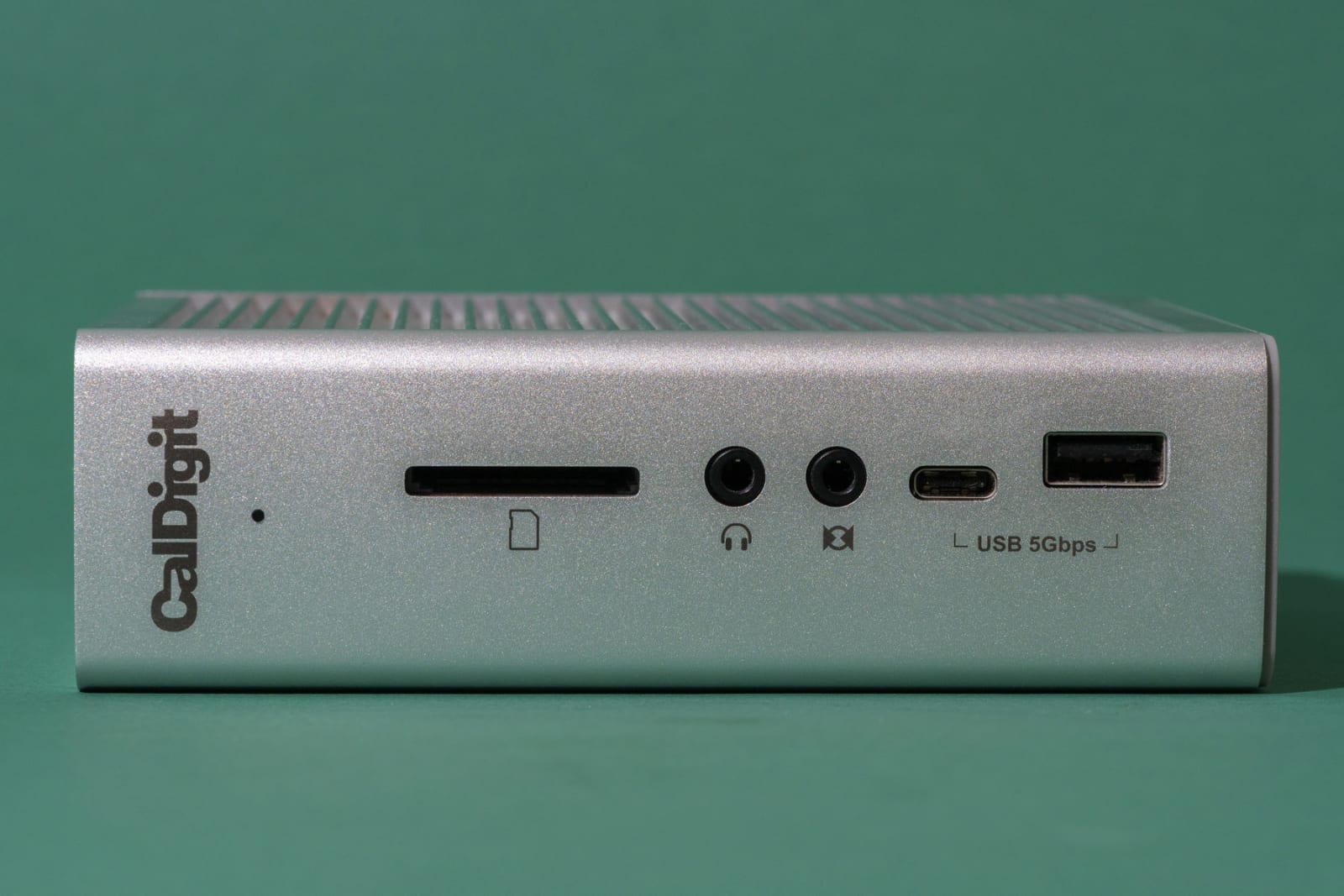
The front of the CalDigit dock has (from right) one USB-A 3.2 Gen 1 port, one USB-C 3.2 Gen 1 port, audio-in, audio-out, and an SD card slot. Photo: Michael Murtaugh
The TS3 Plus provides two Thunderbolt 3 ports, five traditional USB (USB 3.2 Gen 1 Type-A) ports, an SD card slot, DisplayPort, Gigabit Ethernet, separate audio-in and -out jacks, S/PDIF digital audio, and two USB-C ports, one of which (the one on the back) supports the faster USB 3.2 Gen 2 transfer speeds.

The back of the CalDigit dock has two Thunderbolt 3 ports, as well as four USB-A 3.2 Gen 1 ports, one USB-C 3.2 Gen 2 port, Gigabit Ethernet, S/PDIF audio out, and a DisplayPort connector.
In our USB-A testing with Samsung's Portable SSD T3, we measured average read speeds of 340 MB/s and write speeds of 264 MB/s on four of the five ports. Those speeds are about 20 to 30 percent slower than the results we got when we plugged the drive into the Mac directly. However, the other docks we tested provided similar results—our test drive exhibited similarly slower speeds with every dock. The fifth port (the lowest one on the back of the CalDigit dock) produced faster speeds of 422.7 MB/s read and 383 MB/s write. The USB-C 3.2 Gen 1 read and write speeds were almost identical to those of the slower four USB-A ports, while the Gen 2 port was in line with the faster USB-A port.
We also measured transfer speed with SanDisk's Extreme 900 Portable SSD, which CalDigit provided and which we returned after testing. SanDisk advertises this drive as supporting read and write speeds up to 850 MB/s (compared with a max of 450 MB/s for the Samsung T3 drive). USB 3.2 Gen 1 ports can't take advantage of this additional speed because they max out at 5 gigabits (or 625 megabytes) per second, but 10-gigabit USB 3.2 Gen 2 ports can. We found that USB-A speeds were slightly faster with the SanDisk drive, hitting an average read speed of 347 MB/s and a write speed of 309.7 MB/s, though that bottom USB-A port was once again noticeably faster, measuring 419.3 MB/s and 373.7 MB/s read and write, respectively. The more striking difference was between the two USB-C ports: The slower port, on the front of the dock, averaged 351 MB/s read and 313.3 MB/s write, whereas the rear (Gen 2) port was about twice as fast, with read speeds of 736.3 MB/s and write speeds of 605.7 MB/s. We saw even faster speeds when we plugged the SanDisk drive into the dock's open Thunderbolt 3 port using the drive's included USB-C cable: 829.7 MB/s read and 734.3 MB/s write. All this is to say that the TS3 Plus supports fast transfer speeds when paired with the right hardware.
In our tests using LaCie's Bolt 3, a Thunderbolt 3 drive, the TS3 Plus's Thunderbolt 3 read and write speeds were many times faster than its USB results, but—as with all the docks—still a bit slower than when the test drive was connected directly to the computer via Thunderbolt, and slower than the maximum speed LaCie advertises. With the drive hooked up directly to our Mac's Thunderbolt 3 port, read speeds averaged 2,229 MB/s (17.83 Gbps); with the drive connected through the TS3 Plus, they were close, at 2,173 MB/s (17.39 Gbps). Write speeds saw a much bigger drop-off, going from 953.3 MB/s (7.63 Gbps) via direct connection down to 704.7 MB/s (5.64 Gbps) through the dock. Again, these numbers are comparable with our test results across the rest of the docks, and these figures still indicate blazing-fast speeds next to those of most connection types. However, you shouldn't buy this dock (or any dock, for that matter) expecting to see the same performance as you'd get with a direct connection between your computer and the fastest Thunderbolt 3 drives.
The TS3 Plus's SD-card transfer speeds were on a par with those of every other SD-equipped dock we've tested: Read speeds averaged 88.7 MB/s, and write speeds averaged 77 MB/s. That's slower than what we measured with a standalone card reader for our guide to the best SD cards, but it's still respectable.
Four of the CalDigit dock's USB-A ports provide 7.5-watt charging each (1.5 amps at 5 volts), which is slower than what you can get from a good standalone USB charger but comparable to the results from other Thunderbolt docks. The fifth port—the one closest to the end of the dock—provides slower, 2.5-watt charging (0.5 amp at 5 volts), making it better suited for transferring data than for charging phones or tablets. (Unfortunately, the dock has no label to tell you that port provides less power than the others.) Both USB-C ports also support only 2.5-watt charging.
Most Thunderbolt 3 docks, including this one, use DisplayPort for video output. We measured a proper 60-hertz refresh rate when the dock was connected to a 4K DisplayPort monitor.
Almost every other Thunderbolt dock we tested is long and flat, designed to lie horizontally on your desk. The TS3 Plus, on the other hand, can stand vertically or sit horizontally. It measures 5.2 by 3.9 by 1.6 inches, so when it's standing on its shortest edge, it takes up only about 6.25 square inches of desk space, compared with the 26.6 square inches required for the 8.43-by-3.15-inch CalDigit USB-C Pro Dock, our budget pick.
Reviews of the TS3 Plus have been very positive, matching our findings. "Of all the Thunderbolt 3 docks I've tested so far, CalDigit's TS3 Plus is my new favorite," writes Eric Slivka of MacRumors. In another review, 9to5Mac's Jeff Benjamin writes, "[T]he TS3 Plus' diminutive design, and 15-ports in total, make CalDigit's latest dock a very compelling option for Mac users." And Mike Wuerthele of AppleInsider calls it "a superb choice."
Cale Hunt, who tested the TS3 Plus with a PC for Windows Central, also praises its performance and versatility: "With 15 ports, great performance, and a small footprint, the TS3 Plus is about the best Thunderbolt 3 dock you can buy today."
Flaws but not dealbreakers
A Wirecutter editor who uses the TS3 Plus with two LG 27UK850-W monitors and a 2017 MacBook Pro reported issues where one or both displays won't wake up when the computer wakes from sleep mode: "The solution is usually to unplug one or both of the displays and replug. Occasionally it requires a restart." He noted similar quirks with the headphone port. We didn't experience these problems in our testing, but we have seen issues with several Thunderbolt docks when connecting two displays directly to the dock.
Budget pick: CalDigit USB-C Pro Dock
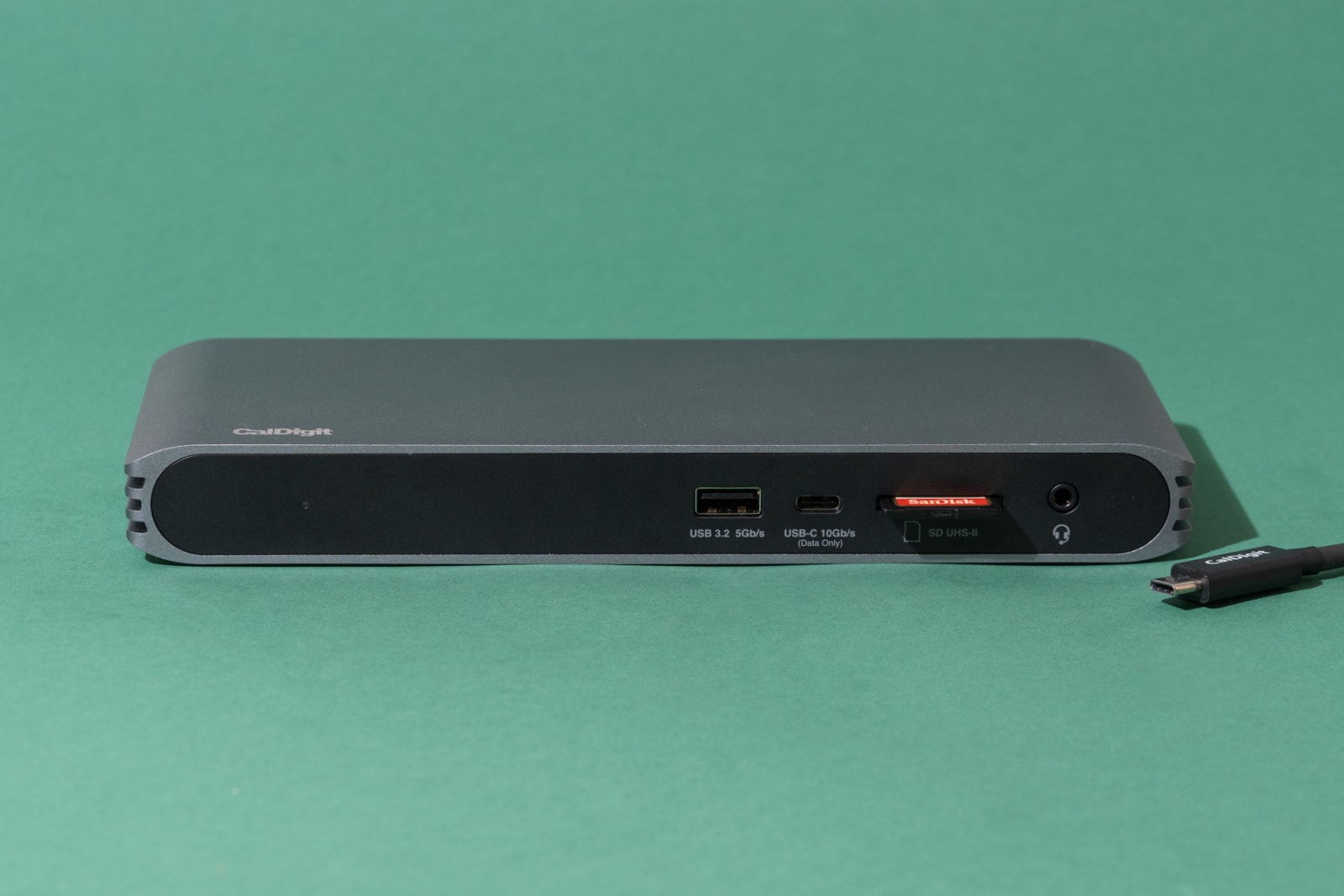
Photo: Michael Murtaugh
If you want most of the power of the CalDigit TS3 Plus but aren't willing to pay for it, consider the more affordable CalDigit USB-C Pro Dock. It has a more limited yet still useful port selection, and it provides enough passthrough power for all 13-inch laptops and many larger ones too. Unlike most Thunderbolt docks, this model also connects to computers that have only USB-C ports and offers almost identical performance. This flexibility makes the USB-C Pro Dock a good choice if you regularly switch between multiple computers, but if you have only a USB-C computer, you'd be better off with a less expensive USB-C dock. Regardless of the computer you're using, however, you can't hook additional Thunderbolt 3 devices to the dock, as it has only a single port, which you use to connect it to your computer. This model also takes up a little more space on a desk than our top pick.
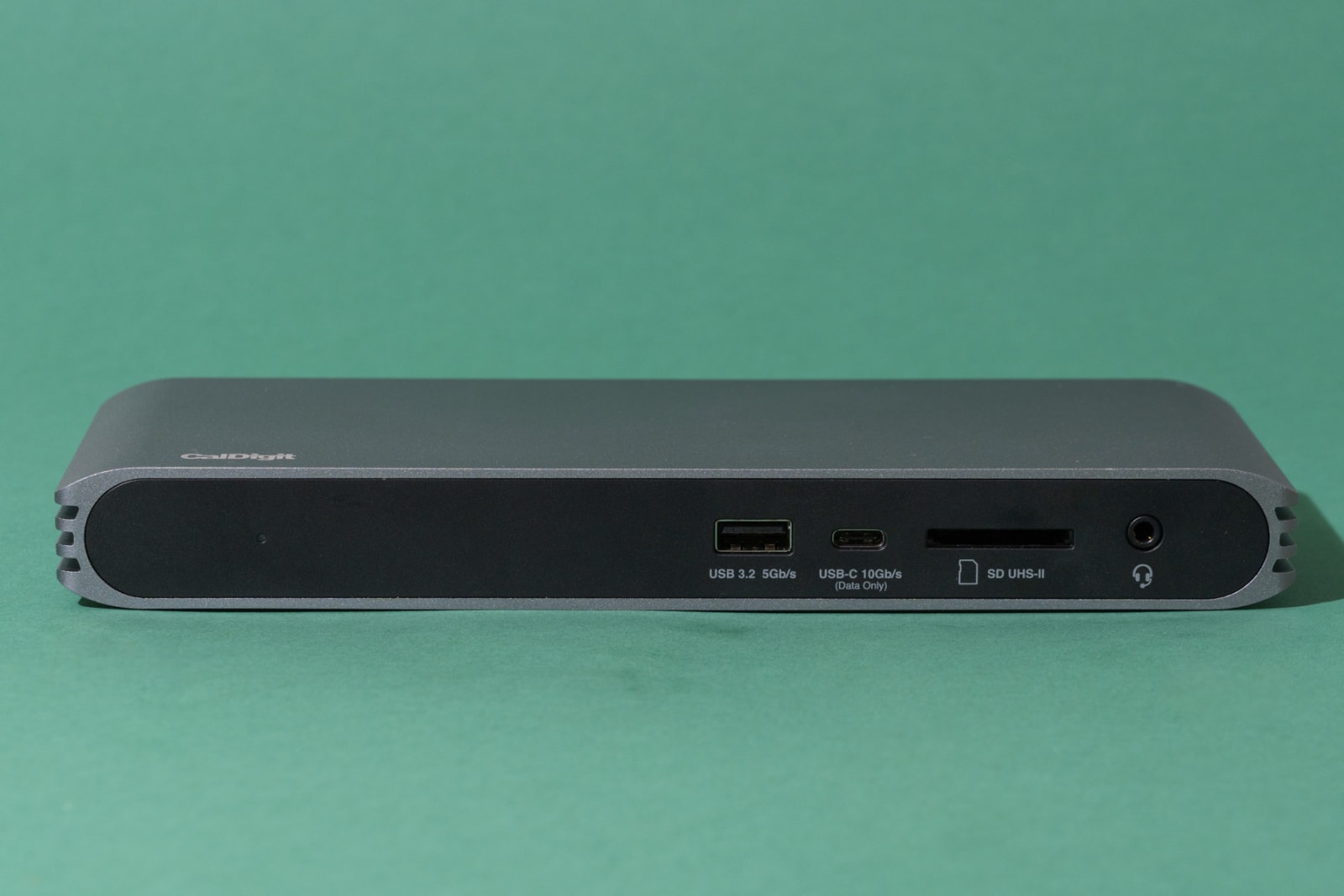
The front of this CalDigit dock has one USB-A 3.2 Gen 1 port, one USB-C 3.2 Gen 1 port, an SD card slot, and combined audio-in and audio-out. Photo: Michael Murtaugh
The USB-C Pro Dock's port array is smaller than that of the TS3 Plus but still pretty good. It has one USB 3.1 Gen 2 Type-C port (supporting speeds up to 10 Gbps) on the front, plus three 5 Gbps USB-A ports. You'll also find an SD card slot, two DisplayPort outputs, Ethernet, and audio, and this dock supports the same 85-watt power output as the more expensive CalDigit model.
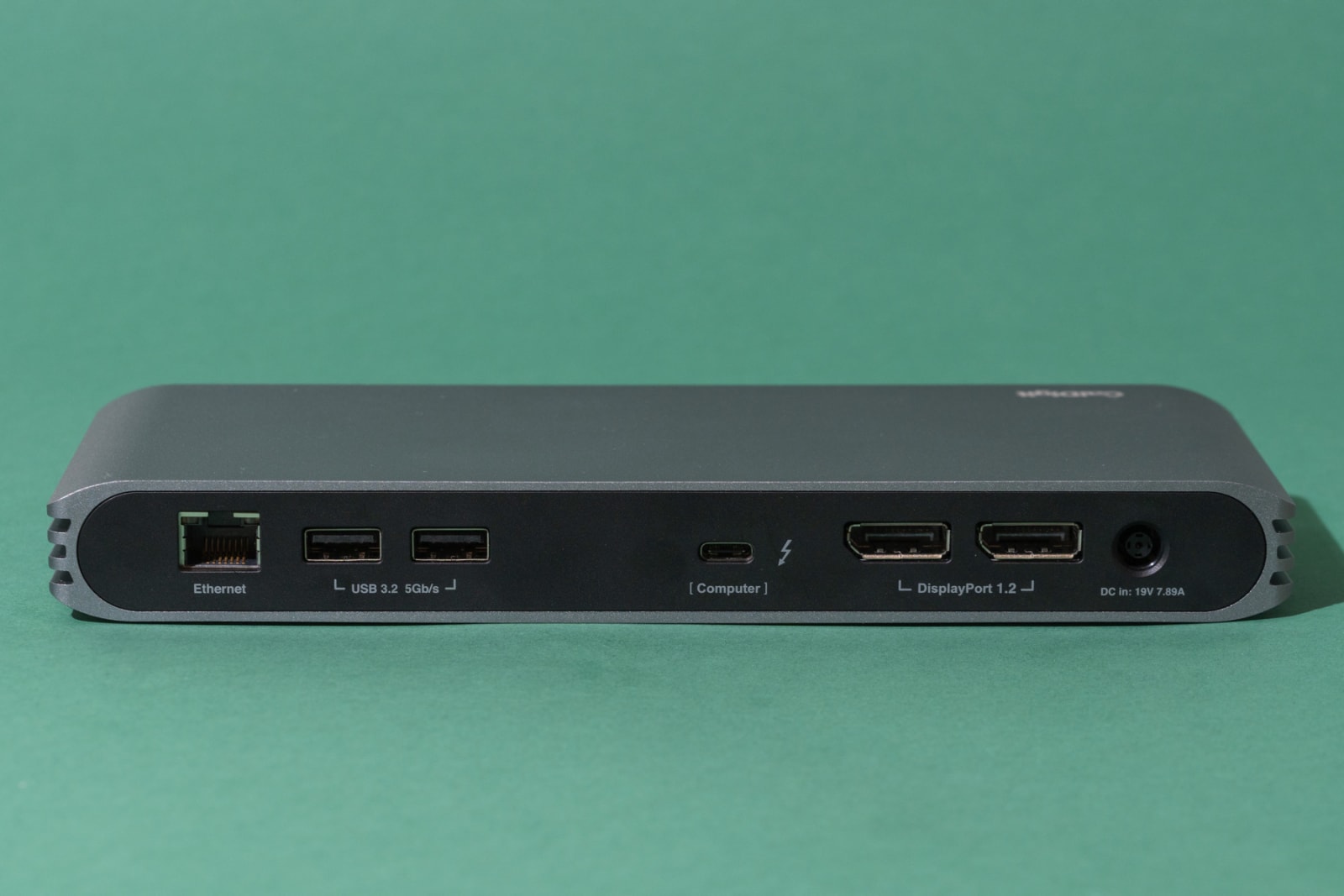
The back of the CalDigit dock offers Gigabit Ethernet, two USB-A 3.2 Gen 1 ports, one Thunderbolt 3/USB-C port, and two DisplayPort connectors. Photo: Michael Murtaugh
In our tests, the USB-A and USB-C ports on the USB-C Pro Dock were faster than the respective ports on the TS3 Plus, with speeds of about 330 MB/s write and 405 MB/s read (we tested this model only with the Samsung drive, not with the faster SanDisk). In all of our other tests, the two units produced comparable results. Notably, the USB-C Pro Dock has two DisplayPort 1.2 connectors, and we were able to properly drive two 4K displays at full resolution with a 60 Hz refresh rate from a 13-inch MacBook Pro. In contrast, USB-C–based computers are restricted to either a single 4K display at 30 Hz or two 1080p displays at 60 Hz, the only limitation compared with Thunderbolt 3 machines.
The USB-C Pro Dock is larger than the TS3 Plus by about 3 inches in width and ¾ inch in depth, and you can't stand it on one end as you can the more expensive model. Like its CalDigit sibling, however, the USB-C Pro Dock comes with a Thunderbolt 3 cable, so you don't have to buy one separately.
Cheaper, with fewer USB-A ports: HP Thunderbolt Dock 120W G2
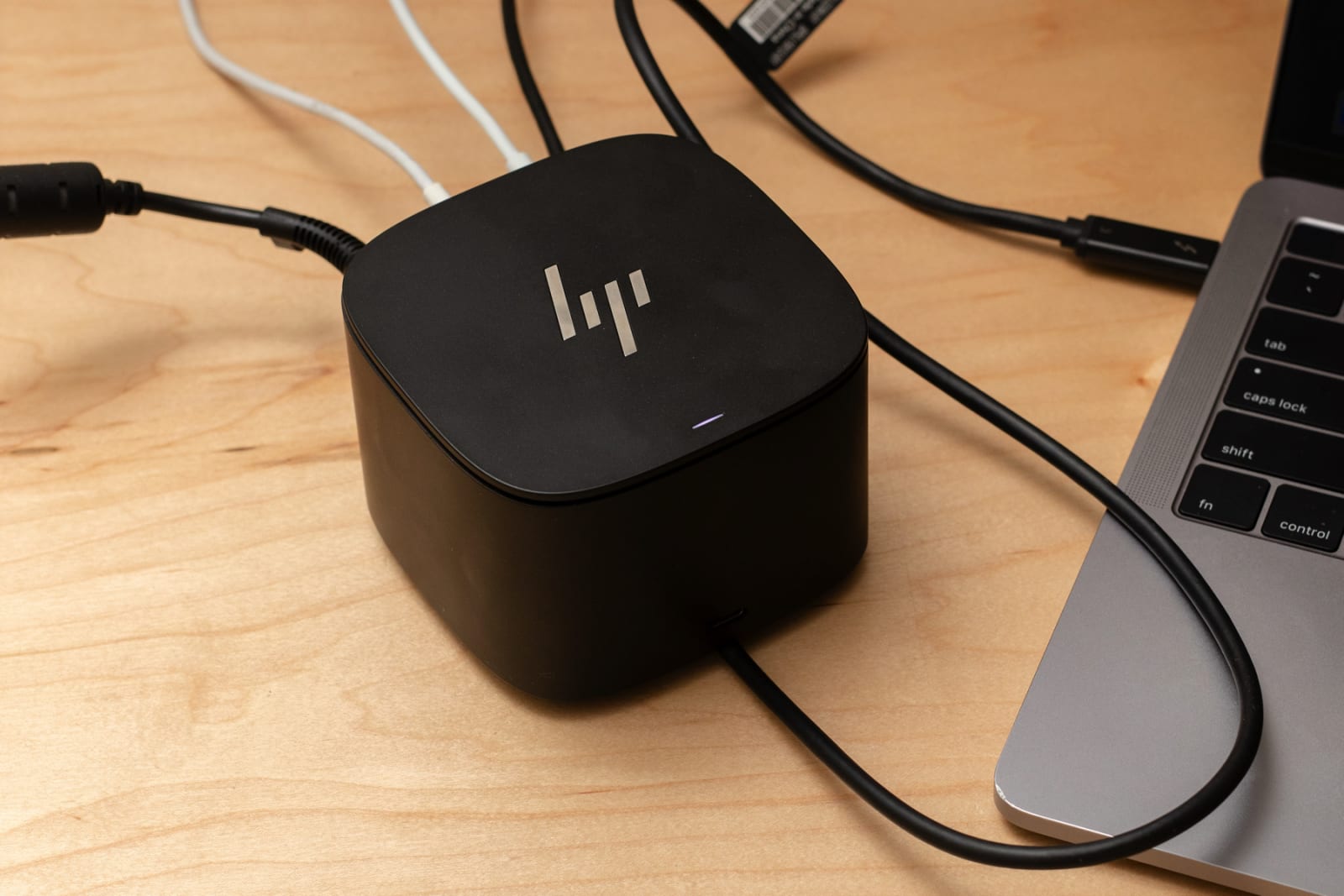
Photo: Sarah Kobos
CalDigit's TS3 Plus is the best option for people who need as many USB-A ports as they can possibly get, but the HP Thunderbolt Dock 120W G2 is a great alternative if you're okay with fewer legacy ports and want to spend less on a dock. Two USB-C ports and two Mini DisplayPort outputs instead of one help make up for fewer USB-A ports and the lack of an SD card slot. And with 100-watt charging, this dock can power any USB-C laptop at full speed.
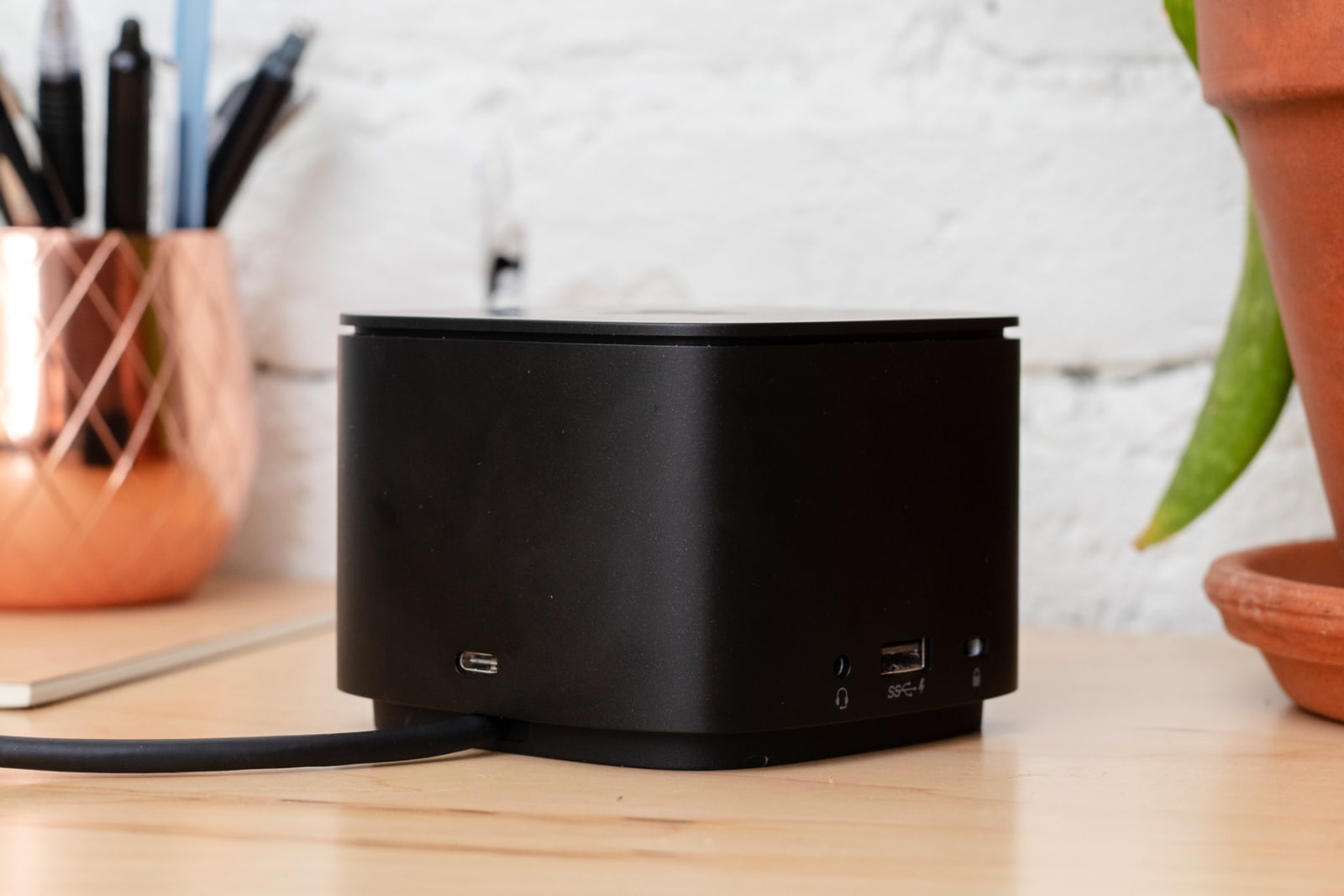
The front of the HP dock has one USB-C port and one difficult-to-replace Thunderbolt 3 cable. On the side, you'll find a combined audio-in and -out port, one USB-A port, and a Kensington lock slot. Photo: Sarah Kobos
The Thunderbolt Dock 120W G2 has three USB-A ports, two USB-C ports, VGA, Ethernet, Thunderbolt 3, two DisplayPorts, combined audio, 100 W charging, and a Kensington lock slot. It's the second USB-C port that sets this dock apart from the rest, as this is the only model we've seen to include a second such port while remaining at a reasonable price.
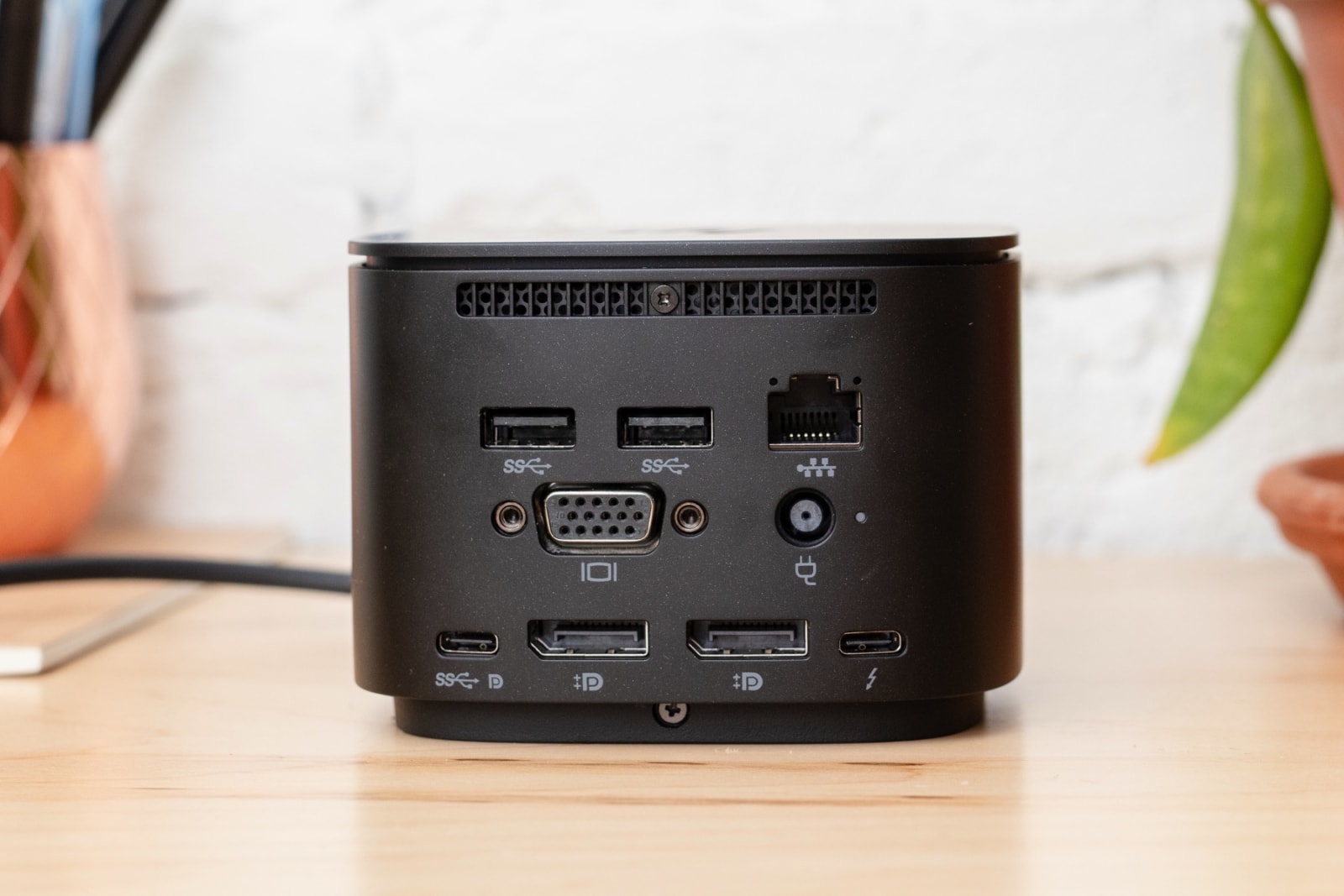
The back of the HP dock has two USB-A ports, Gigabit Ethernet, VGA, a USB-C port, two DisplayPort connectors, and a Thunderbolt 3 port. Photo: Sarah Kobos
In our tests, the HP's ports were actually a bit faster than those of the CalDigit TS3 Plus, with the USB-A ports averaging 339.3 MB/s write and 419 MB/s read speeds and the USB-C ports' speeds right in line with those results. The second DisplayPort connector is noteworthy as well because it's pretty rare and allows you to attach up to two displays at the same time without a USB-C–to–DisplayPort cable or adapter.
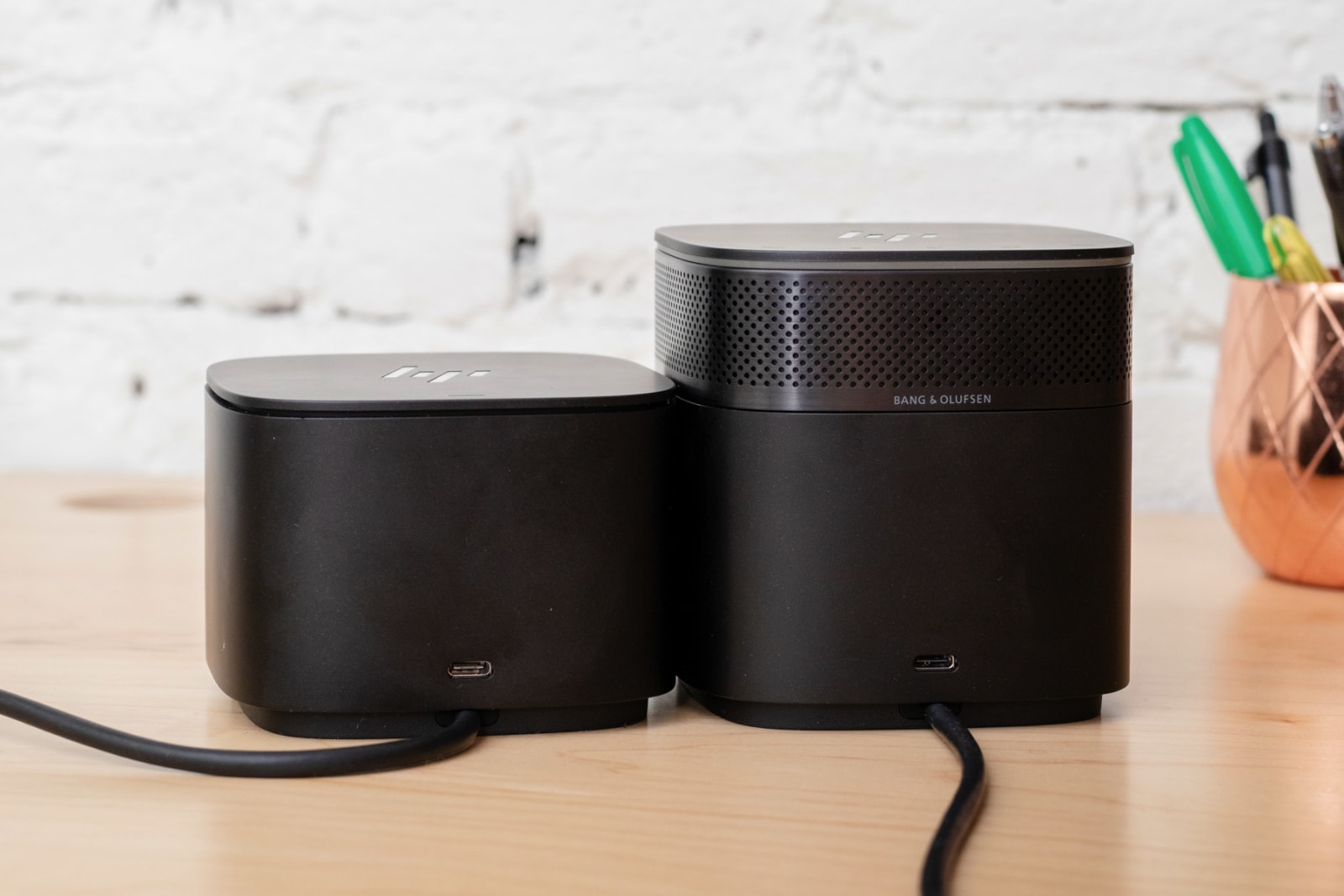
The Thunderbolt Dock 120W G2 (left) and the Thunderbolt Dock 120W G2 with Audio. The two versions are identical except for the speaker module, which you can also buy separately. Photo: Sarah Kobos
Much like the CalDigit TS3 Plus, this HP dock takes up relatively little desk space. The 3.9-by-3.9-inch square with rounded corners will fit pretty much anywhere. The only considerable downside is the Thunderbolt cable that leads to your computer, which is a hassle to replace: If something happens to the cable, you'll have to buy the replacement cable and kit from HP and take off the dock's bottom plate to access the port. But at about 2 feet, the cable should be long enough for most setups.
The Thunderbolt Dock 120W G2 is also available in a version with a speaker built in. We found that it gets louder than a MacBook Pro's speaker, but the audio quality is a bit muddier. It's better suited for conference calls—the manual references Skype for Business and Lync 2013, for example. You can also purchase that audio module separately and install it on the regular dock if you decide you want it later.
What to look forward to
Plugable announced its TBT3-UDZ Thunderbolt 3 and USB-C Dual Display Dock at the CES 2020 trade show. Much like the CalDigit USB-C Pro Dock, it can connect to both Thunderbolt 3- and USB-C-equipped computers. The dock offers dual-display connectivity through either DisplayPort or HDMI—there are two of each connector on the back—as well as seven USB-A ports and 100-watt charging. It will be available in the spring.
The competition
Cable Matters's Thunderbolt 3 Docking Station with 60W Power Delivery and Promise Technology's Thunderbolt 3 Dock TD-300 were runner-up picks in a previous version of this guide and are identical to one another aside from their paint jobs. Each model costs less than our top pick from CalDigit but offers the same number of USB-A ports (five) and an SD card slot. However, unlike our top pick, these docks lack USB-C ports and an S/PDIF output, won't charge larger laptops such as the 15- or 16-inch MacBook Pro as quickly, and use combined audio-in and -out jacks instead of separate jacks. They also have HDMI 2.0 video output instead of DisplayPort; it's difficult, but not impossible, to get a Mac to output 4K resolution at 60 Hz over HDMI.
Like CalDigit's USB-C Pro Dock, the Kensington SD5550T Thunderbolt 3 and USB-C Dual 4K Hybrid Docking Station works with both Thunderbolt 3 and USB-C computers. Kensington's dock is more expensive, and although it has one more USB-C port, it lacks an SD card slot and charges at only 60 watts, which may be too slow for heavy-duty use with a 15- or 16-inch computer.
Like our pick from HP, the Elgato Thunderbolt 3 Pro Dock has two USB-C ports; it adds SD and microSD card slots. But it offers only two USB-A ports and one DisplayPort connection, in a wider design, and carries a much higher price tag.
The OWC 14-Port Thunderbolt 3 Dock has the same ports as our top pick from CalDigit, plus a microSD card slot. OWC's model performed just as well as our pick across our tests but takes up much more desk space. The two docks cost about the same, so you should stick with the more compact CalDigit model unless you value a card reader above desk space.
Plugable's Thunderbolt 3 Docking Station was a previous top pick, but it costs around the same price as our current runner-up and doesn't have an SD card slot or USB-C ports. The only extra feature you get for your money is a DisplayPort-to-HDMI adapter, but that typically costs less than $10 if you were to buy it separately; we think most people will find the extra ports and card reader in our picks to be more important.
Elgato's Thunderbolt 3 Dock provides 85 W charging but has only three USB-A ports and no SD card slot. It's also more expensive than our runners-up, and you can't position it vertically, so it takes up more desk space.
The Belkin Thunderbolt 3 Express Dock has only three USB-A ports and is pricier than more full-featured docks.
StarTech's Thunderbolt 3 Docking Station and Iogear's Thunderbolt 3 Quantum Docking Station offer identical ports—USB-C, DisplayPort, Ethernet, and audio, but only two USB-A—in the same layout but have no high-speed laptop charging. They're not worth the cost considering that more full-featured docks are available in the same price range.
We didn't test StarTech's Dual 4K Monitor Thunderbolt 3 Dock with 3x USB 3.0 Ports since it is larger than our top pick, costs more, and doesn't include an SD card slot. This dock has the same design and ports as StarTech's less-expensive version, but it supports 85-watt charging and it comes with a USB-C–to–DisplayPort cable in addition to its Thunderbolt 3 cable. We don't think the included cable makes this model worth buying.
We also decided not to test the Akitio Thunder3 Dock Pro, because judging by its niche specs and high price, we don't think it's the right choice for most people. It's the only dock we've seen that has a CFast card slot, which some video professionals may appreciate. Similarly, it's the only model we know of with a 10 Gbps Ethernet connection, but most people's networks aren't fast enough to use that speed; it's better suited for pro video peripherals. Neither of those features is bad to have, but they come at the expense of lower power output (60 W) and fewer USB 3.2 Gen 1 ports (three), all for a higher price than you'd pay for most competing docks.
This guide may have been updated by Wirecutter. To see the current recommendation, please go here.
When readers choose to buy Wirecutter's independently chosen editorial picks, Wirecutter and Engadget may earn affiliate commissions.